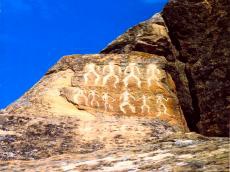|
|
TODAY.AZ / Society
Over 65,000 tourists visit Gobustan State Historical-Artistic Reserve [PHOTO]
13 January 2017 [10:00] - TODAY.AZ

By Azernews
By Laman Ismayilova
On a Daliesque rockscape above the Gobustan town of Azerbaijan lie some of the world’s most important petroglyphs – stone and iron-age figures carved thousands of years ago- and now considered a UNESCO World Heritage Site.
Settled since the 8th millennium BC, the area contains more than 600,000 distinct paintings, going as far back as 20,000 years to as recent as 5,000 years ago. The rock paintings in the State Historical-Artistic Reserve depict a wide range of figures and scenes, including various hunting scenes, war scenes, trading scenes, and individual animals, and people.
In 2016, over 65,000 tourists visited the Gobustan Reserve, which is located 56 km from Baku.
The Culture and Tourism Ministry told Trend that the number of visitors is more than doubled compared to 2015, while bulk of them are foreigners.
Some 8,155 of the tourists visiting the Reserve last year were from Russia, 6,811 from Arab countries, 1,582 from China, 1,464 from Germany, 1,320 from Iran, 1,215 from Japan, 1,040 from the U.S., 974 from Turkey, 864 from Italy, 852 from England, 620 from France.
The Ministry linked the growth with several important factors, including launch of a new museum at the petroglyph site, whose setting is magical with wide views out across the opal Caspian, as well as promotion work.
The Gobustan petroglyphs were repeatedly investigated by the famous Norwegian explorer and adventurer, Thor Heyerdahl, who recognized local boats petroglyphs as the oldest known images of pirogue in the world.
These vessels, similar to the old Scandinavian ships, prompted him to make sensational hypothesis statement about the connection between Norwegians and Azerbaijanis.
Thor Heyerdahl concluded that the ancestors of the Scandinavians were the migrants from Azerbaijani region.
Apart from petroglyphs, there is also this musical gemstone known as Gaval Dash, which makes a tambourine-like sound when it is hit in different points.
Another interesting touristy spot is a stone slab with a Latin inscription dated by the first century. The stone lab was left here by 12th Roman legion of the Emperor Domitian, which indicates that legion had stayed here.
The trip to Gobustan can be combined with a visit to a lovable series of Mud Volcanoes, little grey mounds and pools that bubble and burp merrily around 10km further south.
Every twenty years or so, a mud volcano may explode with great force in Gobustan, shooting flames hundreds of metres into the sky, and depositing tonnes of mud on the surrounding area.
The appearance of the Zoroastrian religion in Azerbaijan is closely connected with this geological phenomena, and Azerbaijan's etymology – Land of the Eternal Fire derives from its Zoroastrian history.
One can reach the destination by taking buses from the Bus Station then by finding a taxi driver in Gobustan town. There are two ways to drive to the mud volcanoes – approaching from the south adds several kilometers but is much easier than the bumpy direct northern approach.

























URL: http://www.today.az/news/society/157706.html
 Print version
Print version
Connect with us. Get latest news and updates.
See Also
- 30 December 2025 [14:38]
Azerbaijan reiterates clear stance on one-China policy - 30 December 2025 [14:01]
Azerbaijani and Turkish tankers send distress call off Istanbul coast - 30 December 2025 [12:36]
Somalia thanks Azerbaijan for support of territorial integrity - 30 December 2025 [11:46]
Azerbaijan ranks first in CAREC for fintech regulation - 30 December 2025 [10:21]
Baku named World Capital of Sport after landmark year - 30 December 2025 [01:20]
Leyla Aliyeva, Arzu Aliyeva and Alena Aliyeva join festive celebrations for children with special needs in Baku - 29 December 2025 [15:17]
Azerbaijan reiterates support for Somalia’s territorial integrity - 29 December 2025 [14:35]
Azerbaijan cancelling part of excise duties paid to compulsory health insurance fund - 29 December 2025 [12:34]
President Ilham Aliyev visits Baku White City - 29 December 2025 [12:06]
Azerbaijan launches Cybersecurity Monitoring Center under Ministry of Health
Most Popular
 The inconvenient truth: who actually owns the road through Meghri
The inconvenient truth: who actually owns the road through Meghri
 Azerbaijan sees weekly jump in gold prices
Azerbaijan sees weekly jump in gold prices
 Azerbaijan observes Lawyers' Professional Day
Azerbaijan observes Lawyers' Professional Day
 Conference on civil defense work results held in Shamakhi
Conference on civil defense work results held in Shamakhi
 Jubilee event marking 75th anniversary of Professor Ibadulla Aghayev held in Baku
Jubilee event marking 75th anniversary of Professor Ibadulla Aghayev held in Baku
 Kevin Durant scores 30 points to lead Rockets to dominant win over Cavaliers
Kevin Durant scores 30 points to lead Rockets to dominant win over Cavaliers
 Capacity building in assistive technology supports inclusive health [INTERVIEW]
Capacity building in assistive technology supports inclusive health [INTERVIEW]
